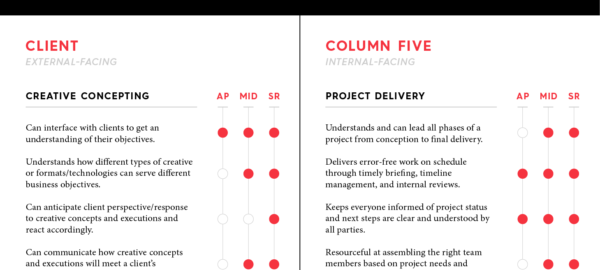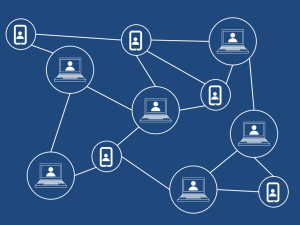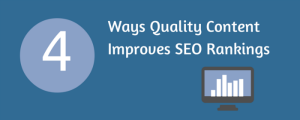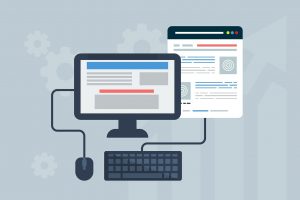— June 27, 2019
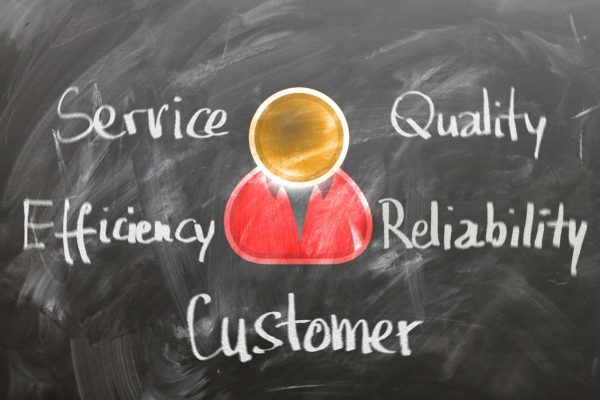
geralt / Pixabay
Our agency’s vision is “to build a future where everyone can live healthy and fulfilled lives.” Work plays a big role in anyone’s life, but finding purpose in your work can be challenging when you don’t know how it connects to your company’s big picture. Even in our own agency, sometimes it’s hard to know exactly how our individual jobs contribute to our vision and why they’re meaningful to our Column Five community. That’s why we’ve been taking steps to provide more clarity about what every person in our agency does, what their job expectations are, and why they matter.
Thus far, it’s been a helpful way to keep our team on the same page, and we think it’s something more organizations should explore. So today we’re giving you a behind-the-scenes look at the tools that help us do it.
But First, Back to the Beginning
In our early years, we were pretty free-wheeling about our roles and responsibilities. We had a flat organizational structure, and everyone was focused on their own work.
But as we took on more clients and more employees, we realized we needed a clearer chain of command and some proper organizational structure. Soon, some of our team moved into management positions, and we made more distinctions about people’s roles, job titles, etc. Everyone knew what they were hired to do, and we implemented check-ins to address issues, answer questions, and keep us all on the same page. That approach to roles and responsibilities worked alright.
But over time, it got a little murky when it came to conversations about things like promotions, compensation, and career goals. We didn’t have the clearest roadmap for career growth, we didn’t have defined attributes for senior positions, and there were a lot of gray areas. When these conversations came up, employees would talk to managers, managers would talk to higher leadership, and then report back to employees. This game of telephone was frustrating for employees and, frankly, inefficient for leadership.
In addition to that, we realized that there was a bit of a cultural disconnect. People couldn’t really connect the dots between what they did on a daily basis and how it related to our agency’s larger goals. This knowledge gap was our fault, so we took steps to change it.
The 2 Tools That Helped Us Clarify Job Expectations
While we’ve learned a lot about our business over the last decade, we’re always looking for ways to improve. So we started experimenting with two tools to help us better define job roles, responsibilities, etc.
Tool 1: The Contextual Expectations Doc
Anyone hired for a job has a job description, but these job descriptions are often focused on tactical, everyday duties. These are helpful, but we realized we needed to better communicate the “why” along with the “what” for every job. Luckily, we learned about the idea of a Contextual Expectations doc (shoutout to Jonathan Raymond at Refound), which we’ve found incredibly valuable.
This simple document clearly outlines what is expected of a role and how it relates to the company’s larger goals, using the answers to two simple questions:
- Why is this role important? How does this role contribute to our company vision, mission, and values?
Example: Our Producers are responsible for rallying their team and clients to create great work that meets objectives and deepens our client relationships. This clearly maps to two of our core Five Columns Values (Do Good Work and Value Our Partners).
- What does this look like day to day? What are the main job expectations, duties, and goals performed by this role, and what metrics or goals do we use to measure success?
Example: If a Producer’s duty is to deliver an amazing client experience and build trusting client relationships to grow accounts, we measure success through their number of closed deals, customer lifetime value, post-project survey feedback, etc.
So far we’ve created a Contextual Expectations doc for every department. This gives everyone a shared understanding of what is expected and why it matters.
Tool 2: Job Canvas Doc
This idea was pitched to us by our VP of People and Culture Tamara Hlava, who got the idea from Cain Ullah, CEO of Red Badger, a digital consultancy agency. It’s a document that clearly articulates the responsibilities of employees who hold the same role but at different seniority levels (e.g., a junior, midlevel, or senior producer).
Every department has a Job Canvas doc that breaks down expectations and responsibilities so that everyone can see
- What level they’re at
- What is required to move to the next level
For example, here’s how we distinguish different producer levels:
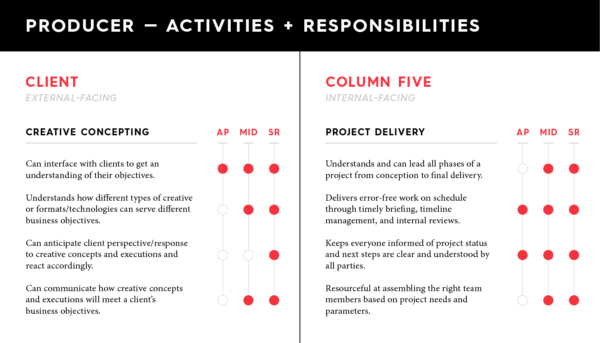
How These Tools Help Us Day to Day
From morale to money talks, the Job Canvas and Contextual Expectations docs have helped us enormously in five important areas.
1) Purpose. Things like remote work, benefits for parents, and extra perks are great for employees, but research has shown that meaning and purpose are incredibly important. (According to MetLife’s 17th Annual US Employee Benefit Trends Study 2019, 88% of employees who feel a strong sense of purpose report feeling satisfied at work.)
When people understand how their individual puzzle piece fits into the larger picture, they feel more ownership and pride in doing good work. The Contextual Expectations doc offers this clarity by outlining how and why what they do matters.
2) Transparency. The MetLife study also found that the number one driver of happiness is an employee’s trust in their company leadership. These docs, specifically the Job Canvas, provide transparency, clearly identifying what we expect and the rubric we use to make decisions about things like promotions and raises. (Side note: One of our other core values is Be Good to Each Other—we know we can’t lead effectively without transparency.)
3) Accountability. Another way to ensure we walk our talk is to maintain accountability—for everyone. By clearly outlining expectations (both in terms of job duties and interpersonal behavior), everyone knows what they are on the hook for, and teams are collectively committed to delivering. This not only reduces frustration and miscommunication but reminds everyone why their own job—and other people’s jobs—are valuable to the agency.
It also prevents those awkward Office Space conversations.
Above all, this type of accountability is crucial to help us do good work—something that means everything to us.
4) Career mobility & raises. We want C5ers to be invested in their future with us, whether they have life changes that make them want to move up a position or pare down. The Job Canvas doc is particularly helpful for these discussions, as it gives employees an understanding of the level they’re at and where they want to be.
Of course, not every position is guaranteed just because someone completes the “checklist” of the Job Canvas, but it helps both employees and managers have a shared language about the topic and provide more context.
Note: It took our leadership team several months to identify, distill, and articulate the elements for every level of our Job Canvas docs. But it was worth it to help us retain people and improve communication going forward.
5) Personal Empowerment. One of the things we’re most proud of is how ambitious and autonomous our team is. We don’t like to micromanage and, luckily, we don’t have to. These documents are a way for employees to take control of their careers in two specific ways:
- They know what proactive steps to further their careers. If a C5er is eager to move up, they have the Job Canvas as a template. This puts things out in the open, so there’s no guessing or confusion about what they should be doing.
- They can hone in on their strengths and weaknesses. We hire well-rounded people, and we expect a lot from them. We encourage them to push themselves, grow, and experiment. But we’d also rather someone lean in to their passions and superpowers than waste energy trying to improve in other areas that we already have covered. If they see that one of the higher responsibilities outlined on the Job Canvas is more in line with their skills and interests, they may be more encouraged to go for it.
Anything that inspires or empowers our people to pursue the things they want to do is a win in our book.
It’s Not Perfect, But It’s a Start
Like anything, there’s a learning curve when you try something new. For us, these tools have provided a useful framework—even if they aren’t perfect. Going forward, we’ll continue to refine, define, and clarify expectations (and determine how valuable they are for each department). But for now, they’ve given us a better language and brought much greater clarity than we had, which has been an undeniably helpful.
We hope you’ll consider how these tools might help your organization.
Business & Finance Articles on Business 2 Community
(46)
